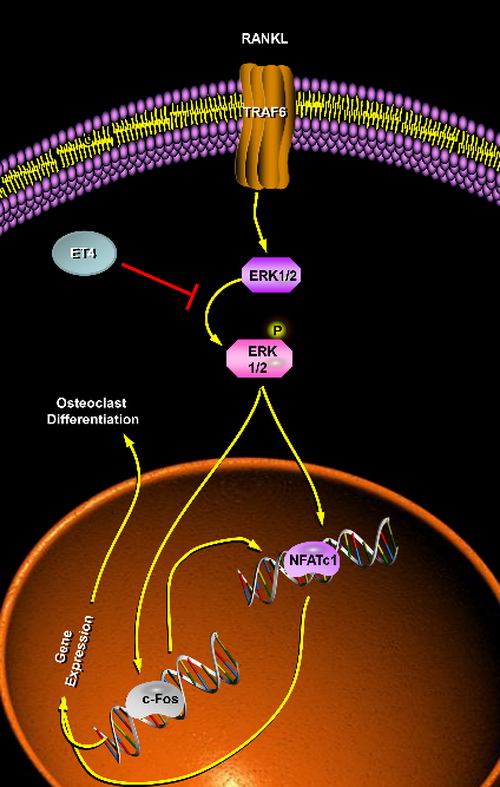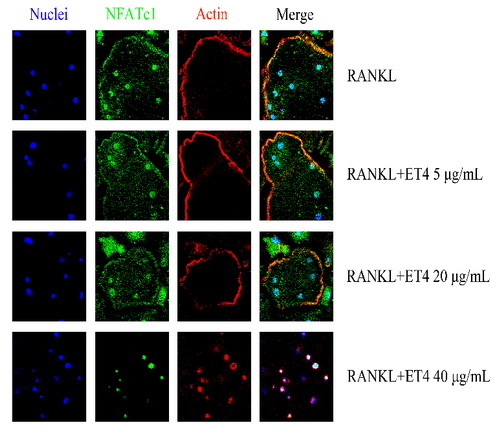科研进展
“塞隆骨抗骨质疏松作用机制的研究”在《Journal of Ethnopharmacology》上发表
2017年10月9日,《Journal of Ethnopharmacology》在线发表了题为"Osteon Myospalacem Baileyi attenuates osteoclast differentiation through RANKL induced NFAT pathways"的研究论文,该论文第一作者为西北高原生物研究所在读研究生崔玉磊,通讯作者为陶燕铎研究员和江磊助理研究员。该论文首次阐明塞隆骨治疗骨质疏松的作用机制,为塞隆骨的二次开发与应用提供了充分的理论依据。
塞隆骨是卫生部于1990年批准的建国以来第一个国家级动物类新药材,并在西北高原生物研究所科研人员的努力下开发了多款产品,使其发挥巨大的药用价值和经济价值。前期药理药效研究表明塞隆骨具有镇痛、抗骨质疏松和类风湿关节炎等功效。虽然对于塞隆骨的药理药效已经得到了认可,但是对于其作用机制却并不清楚,为了揭示塞隆骨治疗骨质疏松的作用机制,实现对塞隆骨的深层次开发,基于陶燕铎课题组多年的研究成果积累以及该课题组的不断努力,最终采用双有机流动相对传统正相色谱柱和亲水色谱柱进行组合的二维制备色谱方法,从塞隆骨提取物中分离出了一个精细组分ET4,并对该组分进行了体外抗骨质疏松作用机制的研究。结果表明在60ug/ml的安全无毒给药剂量下,ET4可以明显抑制破骨细胞的分化。采用RT-PCR方法对破骨细胞的标志性基因进行了分析发现ET-4组分可以明显抑制破骨细胞的标志性基因CTSK, NFATc1, TRAP, DC-STAMP, CTR, OSCAR的表达。最终以时间和剂量依赖性的方式,采用Western blot和immunofluorescence confocal microscopy方法证明ET4组分通过抑制RANKLE诱导的ERK的磷酸化以及c-Fos的活性而间接抑制了破骨细胞分化的关键蛋白NFATc1的表达来抑制破骨细胞的形成,最终实现了治疗骨质疏松的目的。该研究首次揭示了塞隆骨治疗骨质疏松的作用机制,同时ET4精细组分具有很大的潜力可以作为治疗骨质疏松的替代性治疗药物。
ABSTRACT
Ethnopharmacological relevance: Osteon Myospalacem Baileyi, known as Sai long gu (Tibetan language, means “blind rat bone”), is the whole skeleton of Tibet plateau rodentia animal Myospalacem Baileyi. Osteon Myospalacem Baileyi had been widely used in the Tibet region as an anti-osteoporosis drug and since 1991 Osteon Myospalacem Baileyi has been listed in the Pharmacopoeia of People's Republic of China as the first-classanimal new medical material. However, the mechanism of its anti-osteoporosis activities is still unclear. It is very desirable to solve this problem for further study.
Materials and methods: in this study, preparative chromatography was employed to produce the active fraction ET4 from Osteon Myospalacem Baileyi crude. Flow cytometry and MTT assay were used to evaluate the toxicities of ET4. BMM cells were separated from mouse bone marrow to test the inhibition effects of ET4 on osteoclastogenesis. Western blot was used to find out the pathways, through which ET4 could act on osteoclastogenesis. Q-PCR was used to test the osteoclastogenesis marker genes. At last, immunofluorescence confocal microscopy was used to test the osteoclastogenesis master protein NFATc1 nuclei translocation.
Results: In this study we report that ET4, at the dose of 60 μg/mL, significantly inhibited the formation of osteoclasts. Notably, ET4 did not affect the BMM viability at that dose. In addition, Osteon Myospalacem Baileyi could inhibit the expression of osteoclast marker genes, including cathepsin K (CTSK), nuclear factor of activated T cells cytoplasmic 1 (NFATc1), tartrate resistant acid phosphatase (TRAP, Acp5) dendrite cell-specific transmembrane protein (DC-STAMP), calcitonin receptor (CTR), osteoclast associated and immunoglobulin-like receptor (OSCAR). Mechanistically, ET4 dose- and time-dependently blocked the RANKL-induced activation of ERK and c-Fos as well as the induction of NFATc1 which is essential for OC formation.
Conclusions: These data suggest that ET4 might be a useful alternative therapy in preventing or treating osteolytic diseases.

图1 ET4治疗骨质疏松作用机制信号通路图

图2 ET4抑制破骨细胞分化标志蛋白NFATc1表达的激光共聚焦图
Cui, Y., Zhao, X., Mei, L., Pei, J., Wang, S., & Shao, Y., et al. (2018). Osteon Myospalacem Baileyi attenuates osteoclast differentiation through RANKL induced NFAT pathways. Journal of Ethnopharmacology, 213, 65-71.








